Solo in Saigon: 5 Days in Ho Chi Minh City and the Mekong Delta
Before starting my second semester in Hangzhou, China, I started my travels for 2020 in Saigon, Vietnam. I am traveling through Vietnam solo for two weeks, and my journey began in the country’s biggest city, now known at Ho Chi Minh City. I used Ho Chi Minh as a base camp for five days for travels throughout the city and the region. During that time, I took tours to the Cu Chi tunnels and the Mekong Delta. Here’s a look at my time in southern Vietnam!
The Basics
Getting There
Back in October of 2019, I knew I wanted to make the most of my time in Asia, so I began looking for cheap flights to a country I could travel around before heading back to classes in late January. Fortunately, the cheapest flight into Asia from Charlotte, NC (found through a combination of Google Flights, Skyscanner, and Momondo) was to Ho Chi Minh City on Delta Airlines. I flew from Charlotte to Atlanta, and then from there flew 16 hours to Shanghai. After that long-haul flight across the Pacific, I flew four hours to my final destination.
The entire journey took me roughly 30 hours, and it was such a relief to make it to my hostel in Saigon at three in the morning and immediately crash. Journeys to Asia are interminably long, so I am incredibly thankful that I am over here for months and don’t have to make another 12+ hour flight again until May!
Accommodations
In Ho Chi Minh, I stayed at the Saigon Fantastic Hostel for $6 a night. I was stuck up on a top bunk in a really warm room, but the location was great and the woman that runs the place was great. She checked in on me every day, let me pet her adorable and spoiled dog, and helped me book tours to the Cu Chi Tunnels and the Mekong Delta.
Currency
The Vietnamese currency is the Dong, and right now the exchange rate is roughly 23,000 Dong to 1 U.S. dollar. When I first arrived in Vietnam, I pulled 2,000,000 Dong out from an ATM. This sounds like a ridiculous amount of money with a heck of a lit of zeroes, but it’s really only about $86.
Getting Around
To get from the airport to the city center and vice versa, I used the Grab app to order a car. Grab is Southeast Asia’s equivalent to Uber, and my ride in and out of Saigon cost roughly $5 each way.
To get around the city, I strapped on my Tevas or my Nike sneakers and walked everywhere I wanted to go!
To get to the Cu Chi Tunnels and the Mekong Delta, I took buses that were part of the tours I booked through my hostel.
Safety
I have yet to feel remotely unsafe in Vietnam – the people are kind and I have been my typical cautious self when it comes to walking around alone at night and visiting crowded places. Vietnam can be known for petty theft, but as long as you are aware of your surroundings and keep your belongings close, there shouldn’t be an issue.
Highlights of the City
Fortunately for visitors to Saigon, the main sites are mostly centrally located in District 1, which is easily walkable. After getting some much needed sleep, I set out on my first day in Ho Chi Minh to explore.
Ben Thanh Market
My first stop was the Ben Than Market, a huge market filled to the brim with stalls selling clothing, souvenirs, produce, food, and more. As I walked through the maze of stalls, vendors yelled out at me, trying to get me to stop at look at their goods. Unfortunately for them, I had a one-track mind. I was looking for my first meal in Vietnam.
I ended up finding some lovely summer rolls with shrimp that I had with a fresh-pressed glass of watermelon juice. The summer rolls were both light and filling, and the juice was so refreshing in the 90+ degree heat.

The Ben Thanh Market of Ho Chi Minh City

Fresh-made shrimp summer rolls from a food stall in the Ben Thanh Market.

The inside of the Ben Thanh Market
Notre-Dame Cathedral of Saigon
After leaving the market with a full stomach, I headed towards the Notre Dame Cathedral of Saigon, one of the city’s major landmarks. The church was built by French colonialists back in the 1800s, and it received the status of a Basilica in 1962. Unfortunately when I visited, the church was largely covered in scaffolding, much like its namesake in Paris.
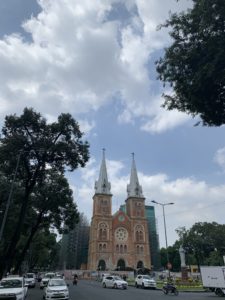
Saigon Central Post Office
Right beside the cathedral is the Saigon Central Post Office, which sounds completely ordinary but is actually quite a stunning French-colonial style building. Also built in the late 1800s, the outside is painted a brilliant yellow and the interior features beautiful arched ceilings and old telephone booths. The entire structure feels distinctly European inside and out, and is worth a stop inside for a look or to mail a post card back home.
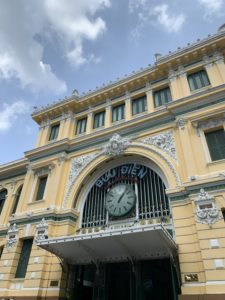
The War Remnants Museum
This museum is the most impactful place that I visited while in Ho Chi Minh City. Entry to the museum museum costs 40,000 dong ($1.75), and for this small cost, visitors get access to several exhibits about the Vietnam War, or the War of American Aggression as it is known in Vietnam. The information and images are a lot to take in, but it is important, especially as an American, to learn about the war that took place here. I went through room after room, becoming increasingly angry as I passed through them. In Vietnam, the United States did a lot of harm, and the negative impact still resonates through Vietnam today.
Two rooms feature the most difficult exhibits in the museum – photos and information that detail the horrors of Agent Orange. This chemical that was produced by American companies and then dumped by American soldiers all over the country to defoliate dense forest did that and much more – it caused a great deal of damage to the landscape and to the people. Civilians and Vietnamese forces alike suffered many physical issues from Agent Orange, and the effects have been passed down now through four generations. Many children in Vietnam have been born with a wide range of deformities and health that have been linked to the chemical, and the museum displays photos of these people that are greatly disfigured as a result of the U.S. war machine.
Agent Orange didn’t just affect Vietnamese people – it also affected U.S. soldiers. My maternal grandfather served in the Vietnam war, and his death due to acute pancreatitis over a decade ago may be linked to Agent Orange. Walking through this museum and reading about the atrocities committed by the U.S. government and American soldiers made me wish even more that my grandfather was still alive, and that I could talk with him about his experience there. While I have been fortunate enough to travel the globe, Vietnam was the only foreign country my grandfather went to, and to fight a war no less. I can’t help but travel through the country wondering where he was and how he fit into the mess of the war.
This museum represents one of the best parts of travel, albeit the most difficult part: learning from a perspective other than your own.
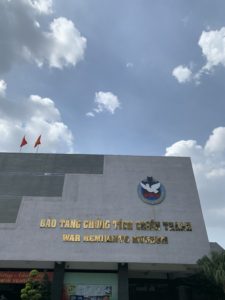
The Bitexco Financial Tower Skydeck
Many major cities have tall, gleaming skyscrapers that feature a viewing platform for visitors to look out on the city, and I always try and make a point of going to the top of them. In Saigon, that tall building is the Bitexco Financial Tower, and its platform is located on the 49th floor. The tickets for this were a bit expensive compared to other attractions in Vietnam at 200,000 dong ($8.75), but not so expensive compared to tickets for similar attractions in other major cities I’ve visited. I have been up to platforms in much taller buildings, from Shanghai to New York, but I enjoyed the quiet atmosphere up in the Bitexco tower. It wasn’t jammed full of tourists, and I was able to quietly sit above the city, observing the hustle and bustle below.

The Bitexco Financial Tower in Ho Chi Minh City

Saigon as seen from the Skydeck of the Bitexco Tower

Me on the 49th floor of the Bitexco Financial Tower
Ho Chi Minh City Museum of Fine Arts
Many visitors end up missing this attraction in Saigon, which is a shame, because it was my favorite place I visited in the entire city. Tickets cost 30,000 ($1.30) a person, and this gives visitors access to three buildings chock full of beautiful art. The art inside was a lovely variety ranging from sculptures to paintings, but the real draw of the museum is the building itself. I was in awe of the spiraling staircases, the bright stained glass, the brightly colored hallways, and the stunning inner courtyard of the main building. I may have used my trusty tripod and remote to capture some photos of myself while roaming the museum.

One of the paintings I especially like in the Ho Chi Minh City Museum of Fine Arts

A photo of myself captured in one of the hallways lining the main building’s huge courtyard

One of the hallways in the Museum of Fine Arts

One of the museum’s magnificent spiral staircases

A work of art that I particularly liked in the Ho Chi Minh City Museum of Fine Arts

A photo I took of myself standing on a balcony in the main building’s gorgeous courtyard
Bui Vien Walking Street
This street, known as a backpackers haven, is best compared to New Orleans’ Bourbon Street. At night the (mostly) pedestrian street is bright with neon lights and is overwhelming with its cacophony of horns, music, and people trying to entice you into their restaurant, bar, tattoo parlor, etc. I was glad that I didn’t stay in this area as I’m not sure I would have gotten any sleep if I had, but it was an interesting area to walk around to people watch and browse shops.
My favorite part of the area was the small, tight alleys that shoot off from the main street. They are full of residences, spas, little restaurants, and more. I explored a few alleys on day and had some of the best noodles ever while sitting on a stool outside of someone’s house.

Bui Vien Walking Street
Tours
The Cu Chi Tunnels
These tunnels, located roughly 60 kilometers from Ho Chi Minh, were used by the Viet Cong during the war to evade U.S. soldiers. I booked a half-day tour through my hostel that cost 117,000 dong ($5) for the bus and guide, and then 110,000 ($4.75) for the entry ticket to the tunnels. The tour was pretty frustrating in that I was picked up 30 minutes after I was told to be ready, I was taken to another location to wait for the bus for an additional 30 minutes, and then we made an unnecessary stop on the way there for a sales pitch. I was ready to go at 7:30 am for a 2 hour drive, but I didn’t actually make it to the tunnels until 11:30.
Fortunately, some of my frustrations were eased when we finally got there and I was drawn into the history there. Our guide was interestingly a Vietnamese man that served in the U.S. forces during the war and did his darndest to flush Viet Cong soldiers out of the tunnels.
He showed us tiny entrances to the tunnels that I would barely be able to squeeze myself through (he proclaimed American soldiers to be fat, so they could never fit into the tunnels) and demonstrated many of the traps that Viet Cong forces set for their American foes. He told tales of pouring gasoline into the ventilation holes of the tunnels and then throwing a lit zippo lighter down after it.
At the end of the tour, we had the chance to go through a 100 meter stretch of the tunnels. Our guide warned us that we’d have to bend over to walk through them, but I was not prepared to be so tall in the tiny tunnel that I had to crawl on hands and knees. Even bent 90 degrees at the waist and bent at the knees, there was no way I could get through. So, I painstakingly crawled through while taking deep breaths and reassuring myself that it was only the length of a football field. At the end, I emerged, breathing heavily and covered in dirt. I cannot imagine the lives that people led down there. Even just being down there for a few minutes felt like an eternity, and it gave me a greater understanding of the conditions people faced during the war.

An entrance to one of the Cu Chi tunnels used by the Viet Cong during the war

Me, kinda freaking out in the tunnel
The Mekong Delta
I did a lot of research on Vietnam travel prior to my trip, and from that research I learned that I absolutely needed to make a trip down to Vietnam’s Mekong Delta. I did some shopping around for tours online and at travel agencies throughout the city, but I ultimately decided on a 2 day 1 night tour booked through my hostel for a whopping $30.
The first day of the tour left a bit to be desired with its rushed schedule full of sales pitches and a lot of driving. The driving is obviously necessary, as the Delta is located 2-4 hours south of Saigon, but the numerous sales pitches did start to get on my nerves. A honey tea tasting was an opportunity for women to try to sell us honey products, a visit to a coconut candy factory ended in workers yelling out deals on boxes of candy, and a stop at a bamboo factory ended in a winding walk through shelves of bamboo product after bamboo product.
In the midst of the sales pitches we visited the beautiful Vinh Trang pagoda, took a small boat down a channel of the delta and got to listen to traditional music while sampling fresh, tropical fruits. These parts of the day were lovely, but short.

Me with the huge smiling buddha at the Vinh Trang Pagoda

The Vinh Trang pagoda in the city of Ben Tre

My boat driver and I on a small channel in the Mekong Delta

The small row boats in the Mekong Delta
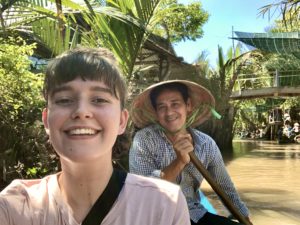
After our final sales pitch in the city of Ben Tre, we continued on for 2 more hours to the city of Can Tho, the main city in the Mekong Delta. It was there that I and two lovely Korean guys split ways with our group to head to a homestay for the night. The rest of the group chose to stay in a hotel for the night, and boy did they miss out. The three of us were picked up right on the river for a 30 minute boat ride during sunset to our homestay that was right on the river.
There, I relaxed in a hammock, ate a lovely dinner of fried shrimp summer rolls with the Korean guys, and then retired to my private room for the night. I fell asleep to the sounds of crickets and other critters chirping in the night, and I woke up the next morning to a rooster crowing. We enjoyed a breakfast of fried eggs and bread before heading back out on the boat to rejoin our group.

The view from the boat ride to our homestay

My room at my homestay

One of the delicious fried shrimp summer rolls I had at my homestay
When we rejoined our group by hopping from our boat to theirs, we headed off to the Cai Rang Floating Market. As the name suggests, the market is completely on the water. Boats full of fresh produce or drinks tied themselves to our boat and negotiated prices right then and there. We also had the opportunity to climb onto one of the big boats and buy a whole pineapple from a man slicing them up in a way that made them perfect for snacking on like a popsicle right there. I split a whole pineapple with a girl on my tour for 10,000 dong ($0.50) each. The floating market was super cool, and made up for a lot of the annoying sales pitches the day before.

A woman selling fruit in a boat directly next to ours

A pineapple boat at the Cai Rang floating market
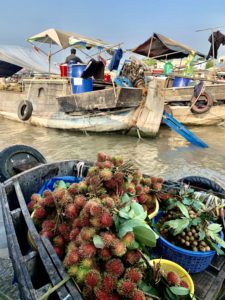
Rambutans for sale in a boat at the Cai Rang floating market

A man selling pineapples for 20,000 dong a pop

Me enjoying my pineapple at the Cai Rang floating market

Me at the Cai Rang floating market in Can Tho city, Mekong Delta
The market, a wonderful highlight of the trip, was followed by two more sales pitches – one at a fruit farm and another at a rice noodle factory. After putting up with those and stopping for a quick lunch, we made our way back to Ho Chi Minh City. I was frustrated with some parts of the tour, but overall I felt the price and timing was worth it to be able to take boats down beautiful parts of the Delta, stay in a local homestay, and experience the floating market. If I were to do it over again, I would consider taking a bus down to Can Tho city directly and looking for a homestay on my own, but the trip was easy and in the end allowed me to experience what I wanted to experience.
My time in southern Vietnam – Saigon and the Mekong Delta – was a fantastic way to kick off my two week trip. I left Ho Chi Minh City already knowing that two weeks was not going to be nearly enough time here!

Very interesting, you have been to a great number of beautiful and educational places. Thanks so much for sharing. I love it and you!!